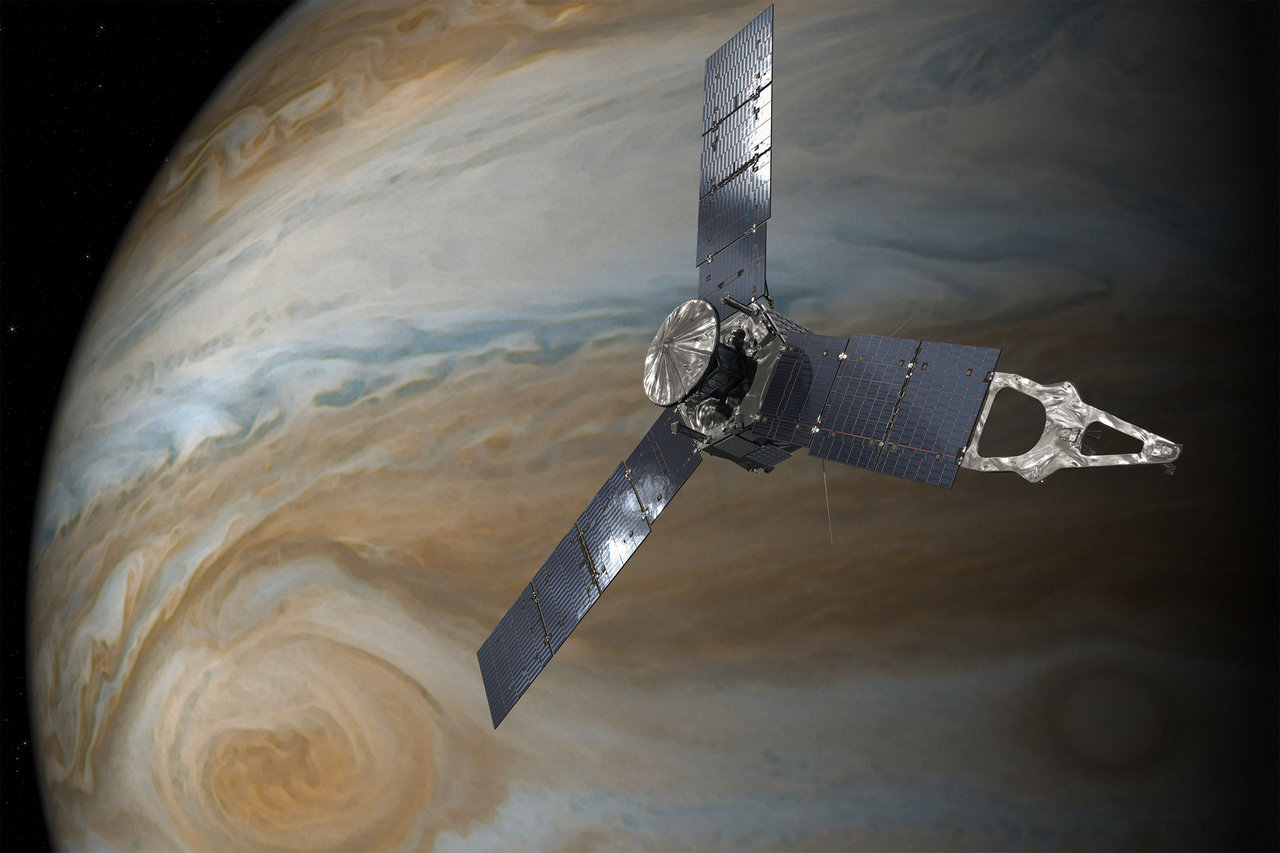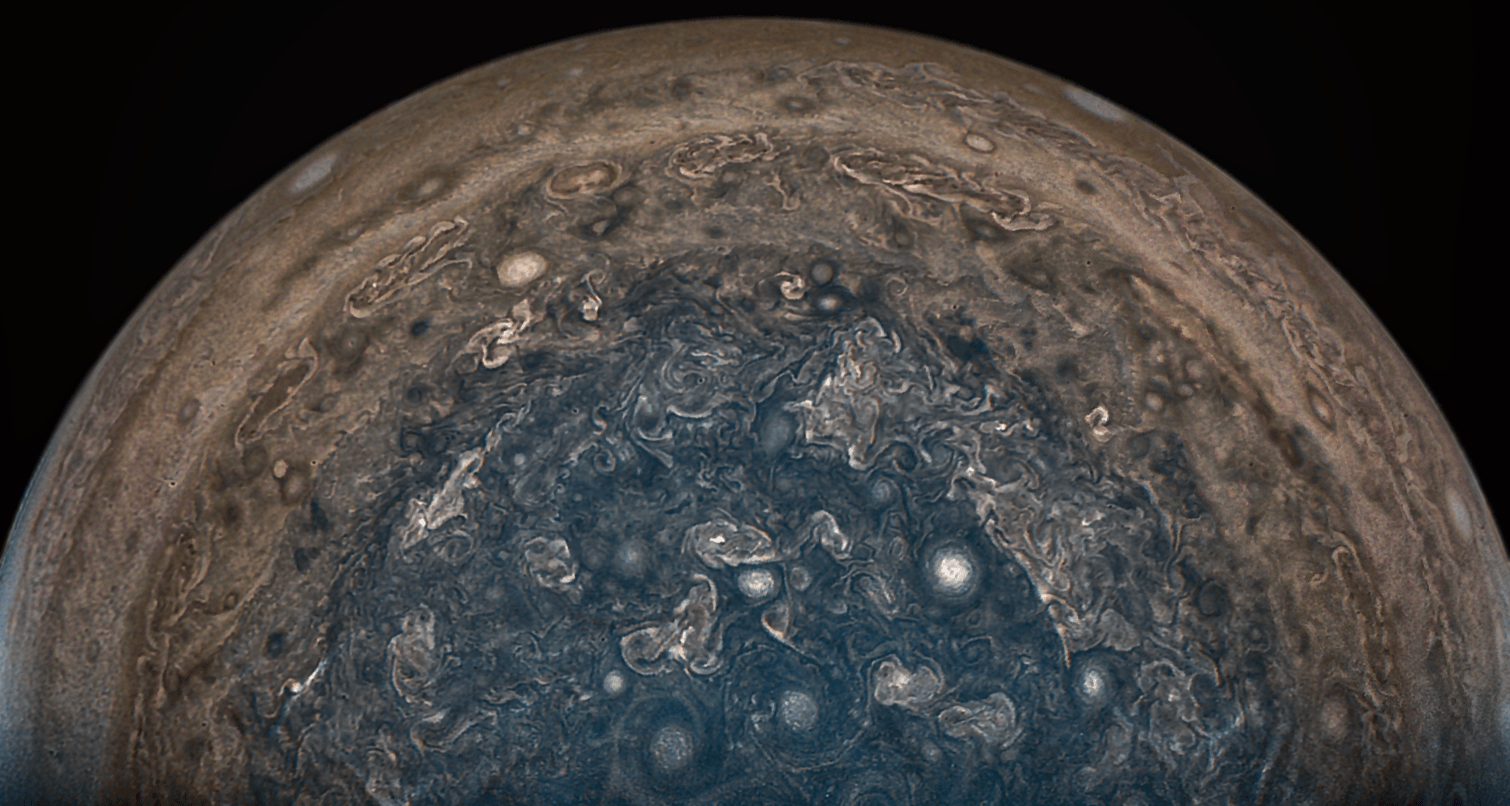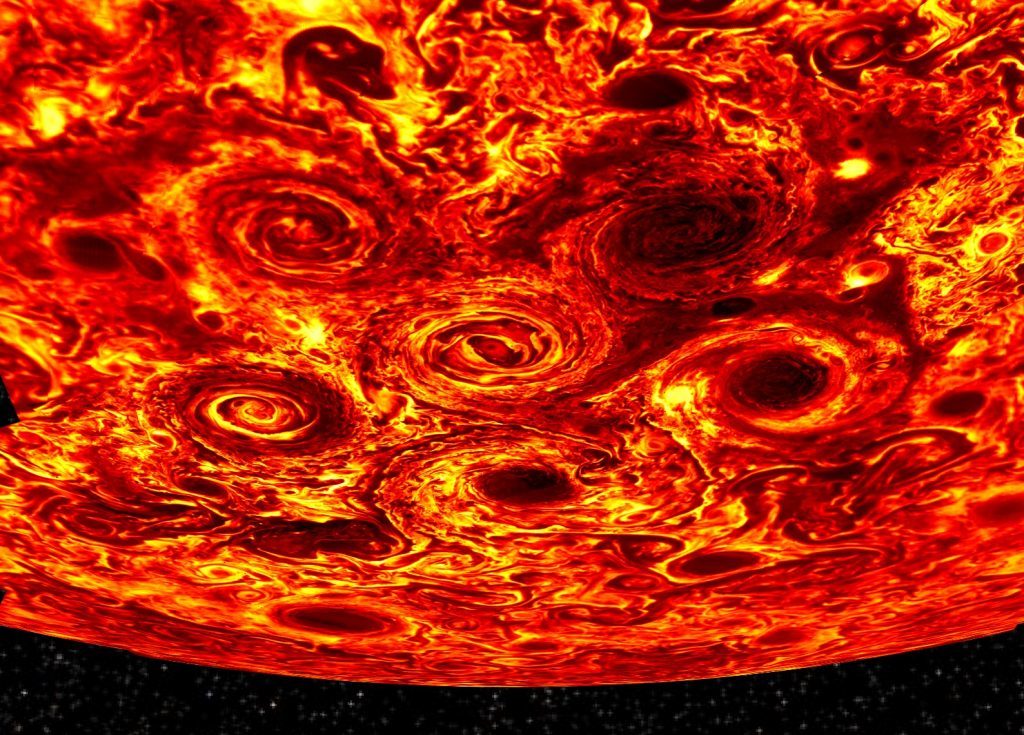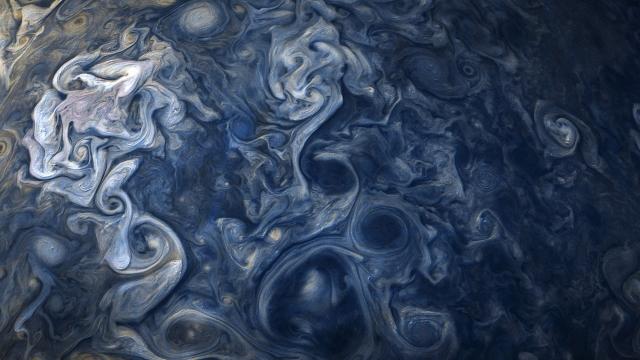NASA’s Juno space probe has been circling Jupiter for the past 20 months, and it’s been transmitting scientific data back to Earth at a furious pace. This week, astronomers are releasing four new studies based on Juno’s measurements, all of which explore the gas giant’s turbulent atmosphere and the stuff that lies beneath its cloudy surface. As their results show, the largest planet in our Solar System is even more exotic than we realised.
A glorious shot of Jupiter’s swirling cloud tops. Image: NASA/JPL-Caltech/SwRI/MSSS/Gerald Eichstädt/ Seán Doran
Most of what we know about Jupiter comes from studying its surface details. Jupiter features a broad diameter that would fit nearly a dozen Earths side by side, but the massive planet spins so fast on its axis that a single day lasts a mere 10 hours. Its iconic Great Red Spot, which measures 16,350km across, is one of many storms currently raging on the surface. Jupiter features alternating, coloured bands of gas, and surface winds that blow in opposite directions, sometimes reaching speeds of 360km/h. This much we’re certain about, but what lies beneath Jupiter’s stormy surface could previously be summarised thusly:
¯_(ツ)_/¯
Gazing intently at the cloud tops, scientists have acquired a two-dimensional perspective of Jupiter. Its winds could be shallow, extending no more than 100-300km in depth, or they could go much, much deeper.

Busy giant: Time-lapse sequence taken by the Voyager 1 space probe as it approached Jupiter, showing the motion of atmospheric bands, and circulation of the Great Red Spot. Image: NASA
Scientists had no idea.
At greater depths, the gaseous atmosphere transitions into a super-dense liquid comprised of hydrogen and helium; this massive, internal ball could feature currents, bands and other hidden internal dynamics, or it could just be single, giant fluidic mass.
Again, we just didn’t know.
And as for the planet’s centre, that’s one of astronomy’s biggest mysteries – Jupiter’s pit could be a solid rocky core, a metallic mass, a dense liquid or something even more alien.
Thanks to the Juno spacecraft, however, our two-dimensional view of Jupiter is quickly expanding out into three-dimensions. This space probe was designed to measure Jupiter’s magnetic field and polar magnetosphere, but it was also built to gaze through its opaque clouds and investigate the planet’s gravity field, mass distribution and deep winds; Juno allows us to see past the gas giant’s churning upper layers and directly into its guts. The latest findings in this regard were published across four papers this week, all appearing in the science journal Nature.
In the first study, led by Weizmann Institute of Science astronomer Yohai Kaspi, scientists have shown that – get this – Jupiter’s atmosphere and its jet streams extend a whopping 3000km below cloud level. To put that into perspective, Jupiter’s atmosphere is so deep you could fit more than two Earths on top of each other and still not reach its full extent. Put another way, Jupiter’s atmospheric flows extend for 1/40th of the planet’s diameter.
Below 3000km, the winds gradually slow down and decay. The pressure down there is about 100,000 times more powerful than what we find at Earth’s surface. Jupiter’s atmosphere, according to Kaspi’s analysis, encompasses a whopping one per cent of Jupiter’s total mass, which amounts to three Earth masses. By contrast, Earth’s atmosphere is less than one millionth of the mass of Earth, so the discovery of such a massive interior region, which is rotating in separate east-west bands, came as a complete surprise to the astronomers.
These findings were made possible owing to Juno’s ability to detect minute differences in Jupiter’s gravitational field.
“We cannot reach the interior with a probe, thus we need to use sophisticated remote sensing methods to reach it,” Kaspi told Gizmodo. “One of these is gravity measurements, which can tell us a lot of information about how the interior mass is distributed. This is how we have been able to learn about the depth of the jet streams and interior structure.”
Kaspi says these findings are important for understanding the nature and possible mechanisms driving Jupiter’s strong jet streams. And because the gravity signature of the jets was found to be tangled up with the gravity signal in the interior, astronomers will now have a better understanding of the interior structure, core mass, and origin of Jupiter.
“Galileo Galilei viewed the stripes on Jupiter more than 400 years ago. Until now we only had a superficial understanding of them, and have been able to relate these stripes to cloud features along Jupiter’s jets,” Kaspi told Gizmodo. “Now, following this study we know how deep these extend and what their structure is beneath the cloud-level.”

Artist’s depiction of Juno orbiting Jupiter. Illustration: NASA/JPL-Caltech
The second study, led by Tristan Guillot from the Université Côte d’Azur in France, was an investigation into the composition of Jupiter’s atmosphere and the stuff that lies deeper still. Using Juno gravity measurements and interior models, Guillot found that Jupiter’s zonal flows extend to about 3000km, which matches Kaspi’s findings rather perfectly. But whereas Kaspi’s team studied gravitational anomalies, or “odd spots”, Guillot’s team analysed Jupiter’s gravitational consistencies. So these two independent teams reached the same conclusion using different techniques, which is a good sign.
Guillot’s team also found that, below 3000km, Jupiter rotates uniformly, rather than with zones and belts rotating at differential speeds as in the atmosphere. This is something scientists didn’t know before.
“It is an almost 50-year old puzzle in planetary science that is solved,” Guillot told Gizmodo. “We didn’t know whether a gaseous planet like Jupiter – but also Saturn, Uranus, Neptune and giant exoplanets – rotates with zones and belts all the way to the centre or whether, on the contrary, the atmospheric patterns are skin-deep. Many lab experiments, numerical simulations had been performed but with no clear picture emerging. Now, thanks to Juno’s amazing accuracy – it measured Jupiter’s gravity field 100 times better than before – we have the ground truth.”
As for the composition of Jupiter’s core, we still don’t know the answer, but these latest results suggest it isn’t a solid, but a liquid, and that it’s bigger than previous estimates. Guillot said this will be a difficult thing to prove because the pressure down at the core is 50 million times stronger than Earth’s atmospheric pressure. Good luck replicating those conditions in a lab!

Juno was directly over Jupiter’s south pole when it took this photo. Image: NASA/JPL-Caltech/SwRI/MSSS/John Landino
Luciano Iess, an astronomer at Rome’s Sapienza University, led the third study. His team studied Jupiter’s gravitational field, which is known to vary from pole to pole. But in another complete surprise to scientists, they discovered a pronounced north-south “asymmetry”, meaning the planet’s gravitational strength doesn’t match at the poles. That’s a weird result, because Jupiter is a “fluid” planet that’s rotating quickly, making it oblate, or squashed at the poles. In theory, the gas giant’s gravity, or mass distribution, should be spread equally at the poles. So what could possibly account for this?
“In short: The winds,” Iess told Gizmodo, explaining that the winds are distributing mass unevenly across Jupiter. “The measurement of the depth of the winds was one of Juno’s most important science objectives. The science team realised even before launch that the most promising way to achieve this objective was to look at the asymmetric part of Jupiter’s gravity.”
He says this gravitational anomaly is likely the product of dynamic phenomena, such as flows in the atmosphere. “It therefore bears the pure signature of the flows below the cloud level,” he said. “By tracking the motion of clouds on Jupiter’s surface, we know that the winds are not North-South symmetric, so also the gravity cannot be perfectly symmetric.”
In the fourth and final study, lead investigator Alberto Adriani from Italy’s National Institute of Astrophysics studied the storms at Jupiter’s polar regions – areas not visible from Earth. By looking at visible and infrared scans of the poles taken by Juno, Adriani’s team was able to document a series of swirling cyclones, all of which produced dramatic polygonal patterns. At Jupiter’s north pole, eight circumpolar cyclones were seen rotating around a single cyclone, and at the south pole, the researchers found five. The exact cause of these storms remains unknown.

Jupiter’s south pole as seen at 5 µm wavelength, showing heat emanating from the planet through the clouds (the darker the colour, the thicker the clouds). Image: NASA/SWRI/JPL/ASI/INAF/IAPS
“The cyclonic structures we observed there, over the poles, do not exist in other planets of our solar system,” Adriani told Gizmodo. “Those kind of structures give a strong characterisation to Jupiter’s atmospheric dynamics and all the other similar [exoplanets] recently discovered outside our solar system.”
When asked to speculate as to the cause of these cyclones, Adriani said the fast rotation of the planet and the heat coming from the deeper layers of the atmosphere are a likely culprit. “The symmetry of the structures is due to their position around the pole, namely around the rotation axis of the planet,” he said. Looking ahead, Adriani would like to combine the new data with microwave radiometer data to investigate how the deeper atmosphere interacts with Jupiter’s most “superficial” upper layers.
So, a lot of questions have been answered, but many new ones are now appearing. Future studies will investigate the depth and structure of Jupiter’s Great Red Spot, along with the forces that might drive the planet’s jet streams. The astronomers are also planning to use Jupiter’s gravitational field to understand more about the planet’s interior structure, including the mass of its central core. This is now possible because, for the first time ever, scientists can finally measure differential rotation inside a gas giant.
Scientists are also planning to measure the way Jupiters’ spin axis moves in time, which could reveal the way its density varies in the deepest layers. Finally, Juno will also be used to measure tides raised on Jupiter that are caused by Io and its other moons. This could provide new insights into the complex inner workings of the Solar System’s largest planet.
[Nature (Kaspi et al., Nature (Guillot et al.), Nature (Iess et al.), Nature (Adriani et al.)]
